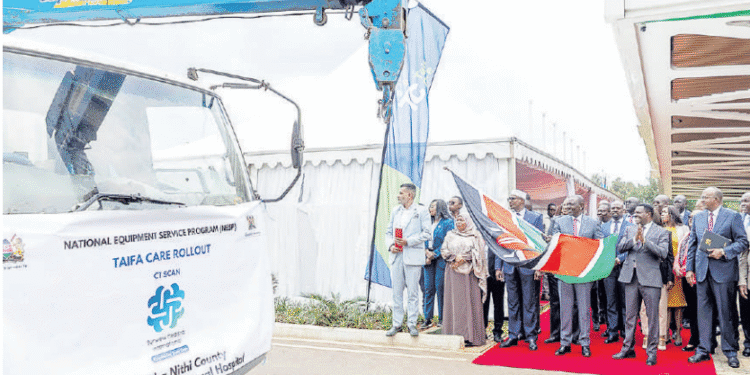Counties medical leasing program has been unveiled, with counties set to remit 90 per cent of medical equipment fees to vendors under a new fee-for-service model, replacing the controversial Managed Equipment Services (MES) scheme. According to The Star, this initiative, dubbed the National Equipment Support Programme (NESP), aims to bankroll advanced medical equipment for hospitals without upfront costs to counties, ensuring vendors handle supply, installation, maintenance, and upgrades.
The counties medical leasing program, flagged off by President William Ruto on August 7, 2025, at State House, targets Level 5 and referral hospitals, promising to enhance healthcare delivery and support universal health coverage (UHC) goals in Kenya.
The program’s structure revolves around a fee-for-service (FFS) arrangement, where counties pay vendors based on pre-agreed tariffs for equipment usage, remitting 90 per cent directly to them while retaining a small portion for administrative purposes.
This shift addresses past MES criticisms, where counties felt burdened by fixed payments for underutilized equipment due to infrastructure gaps or lack of trained personnel.
Vendors like Sunview Medipro International, in partnership with manufacturers such as GE Healthcare, FujiFilm, and United Imaging, will deploy high-end technologies including CT scanners, mammogram machines, ultrasound systems, dialysis units, digital X-ray machines, and ICU equipment.
The initial phase focuses on 98 diagnostic imaging CT scanners, two mammogram machines, 400 operating theatres, and 400 laboratories, with installations underway at facilities like Jaramogi Oginga Odinga Teaching and Referral Hospital in Kisumu and Kerugoya County Referral Hospital.
President Ruto emphasized the program’s role in leveraging private-sector expertise to modernize healthcare, stating during the launch that it would free up county resources for patient care, hiring more health workers, and procuring essential supplies.
Council of Governors principal supply chain officer James Kamau highlighted the cost savings, noting that counties previously spent millions on maintenance under MES, often for equipment that sat idle due to power shortages or staffing issues.
The new model ensures vendors bear the risk of downtime, incentivizing efficient service and upgrades, while counties benefit from reverse referrals, allowing patients to access specialized care locally rather than traveling to Nairobi.
The bankrolling mechanism relies on national government reimbursements to vendors, funded through the health ministry’s budget and potentially supplemented by development partners.
This approach minimizes financial strain on counties, which remit fees collected from patients or insurance claims directly to vendors. Health Cabinet Secretary Aden Duale assured that the program aligns with UHC objectives, promoting equitable access to quality care.
However, concerns linger about transparency in vendor selection and tariff setting, with opposition figures calling for audits to prevent overpricing similar to MES scandals.
The program’s rollout includes training for local staff and community sensitization to maximize utilization.Industry experts view the counties medical leasing program as a game-changer for Kenya’s healthcare landscape, potentially reducing wait times for diagnostics and surgeries in underserved areas.
By decentralizing advanced equipment, it could lower overall treatment costs and improve outcomes for chronic conditions. Social media reactions reflect mixed sentiments, with users praising the innovation but questioning implementation timelines, especially in rural counties like Lamu and Wajir, where logistics pose challenges.
The program’s success will depend on robust monitoring, as emphasized by the Kenya Medical Association, to ensure equipment remains functional and accessible.
As deliveries continue over the next eight to 10 weeks, the counties medical leasing program positions Kenya to attract more private investment in health infrastructure.
Vendors like Sunview Medipro have committed to ongoing support, including spare parts supply and consultations, fostering long-term sustainability.
The 90 per cent fees remittance to vendors under the counties medical leasing program ensures accountability, as payments are tied to performance metrics, deterring the inefficiencies that plagued MES. Counties stand to gain from freed-up budgets, potentially reallocating funds to primary care and preventive services.
Critics argue that without clear guidelines on fee structures, the counties medical leasing program could lead to disparities between wealthier and poorer counties.
The government has pledged equitable distribution, prioritizing high-need areas to bridge healthcare gaps. In conclusion, the counties medical leasing program, with its 90 per cent fee remittance to vendors, represents a bold step toward modernizing Kenya’s health system.
As equipment rolls out, stakeholders remain watchful to ensure it delivers on promises of efficiency and equity, ultimately benefiting patients nationwide.

















